
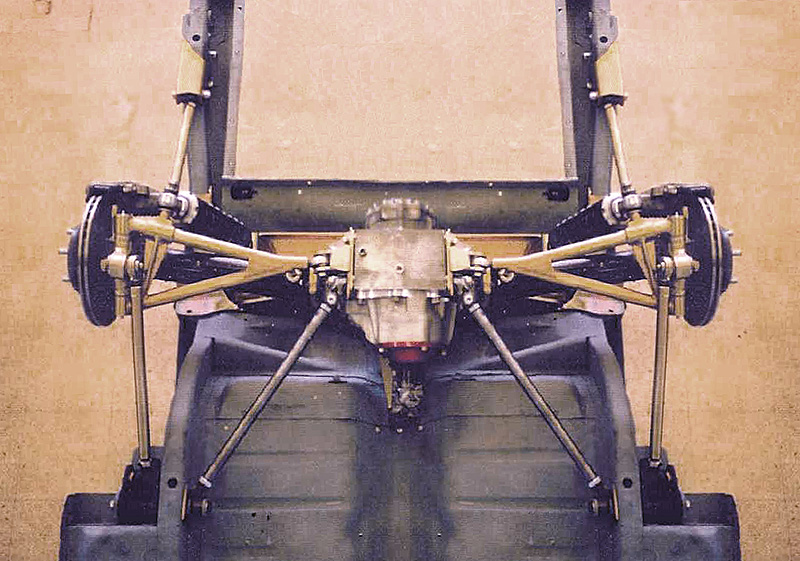
 |
 |
 |
 |
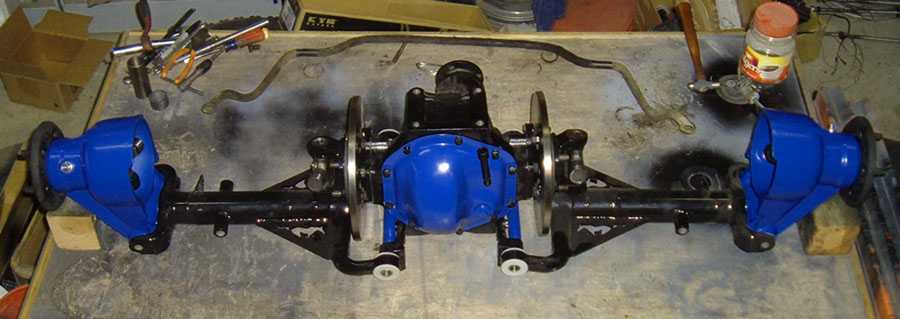 |
You are not logged in. Would you like to login?

![]() Offline
Offline
Well I'm getting frustrated,I got my unit disassembled which was a learning curve, found a place that would respline and shorten axles,But now I find out my half shafts are to small to respline,I'm just not ready to spend $500.00 on new ones,checking into ford Explorer front shafts now to see if I can have these resplined,What a dirty greasy stinkin job tearing these units down. ![]() Once I get this axle problem solved I'll start on the cradle mock up.
Once I get this axle problem solved I'll start on the cradle mock up.
Vern
![]() Offline
Offline

and so it begins. I would love to tell you that from hear on out you you will have all the correct parts and that the install is a piece of cake. The truth is this is the first of several to many issues you may have. My Jag project has had lots of issues, best advice I can give, is deal with each problem as it comes. As far as you axles what if you have them shortened and use the original splines?? I looked in to two viable options on the Jag half shafts and I think either could work for your set up.
here is an excerpt from my web page on narrowing the Jag pieces, I would think it could apply to the Ford pieces.
Bevel and weld:
- Hot rod builders have used this first technique to narrow the half shafts of Jaguar IRS units for their street rods since Jaguar came out with IRS in the 60s. The concept is simple, place a half shaft in a lathe and cut out the section needed to achieve the desired length. Then on each end piece bevel from the cut edge back toward the yoke so that the shaft of each yoke ends up with a point on it. Line the two shafts up, point-to-point in a piece of angle iron, making sure that the yokes are perfectly in phase with each other, and begin filling the area between the two pieces with weld. A competent welder should be able to fill in the shaft and return it to a solid piece. Using this technique results in maintaining a solid shaft just as the unit was originally designed, and the welded section will probably be stronger than any other part of the shaft. However, there are two difficulties in this technique, one, getting the yokes lined up, and two, ending up with a straight half shaft that is not slightly bent or warped. If the half shaft yokes are out of phase even 1 or 2 degrees or the shaft is bent, the slight variation will result in horrible vibrations and/or broken u-joints. Assuming everything is correctly welded, together this technique has proven to be strong and reliable. 
Red lines show beveled cuts and the green area is the weld
Turn down, cut, press & weld:
- Another option is to use the yokes from the solid half shafts to make a mechanical tubing type half shaft. This is done by turning down a section of the half shaft near each yoke end to a size that will be a .002 to .01 press fit in the mechanical tubing that will be used to connect the two ends. Then cut the yoke ends off of the half shafts, leaving about 1" - 2" of turned down shaft attached to each yoke. As mentioned, thick wall mechanical tubing cut to the correct length will join the two yoke ends together by means of a press fit as well as a bead of weld around the base of the yoke and mechanical tubing. One major advantage to using this technique is by converting to a tubing type shaft, weight is shed and, if repairs are needed in the future, they are simple to do just as you would with any other tubing type drive shaft. You may wonder how tubing could be strong enough, especially when you consider the original shafts were solid, but the reality is that the modern materials used to make thick wall mechanical tubing are stronger ounce for ounce than the materials used to forge the original shafts and the strength is probably fairly close, if not better, on the modified shafts. This option is usually less expensive than the one mentioned above because it is easier for a driveline shop to index the yokes and avoid having the half shafts warp. After discussing the options with several machine shops, as well as others who had narrowed a Jaguar rear end, I decided to have my shafts narrowed via this technique for both cost and reliability. NOTE the larger the diameter of the mechanical tubing used, the stronger the half shaft, just as an example, a tube 1.75" O.D. is almost 4 times stronger than tubing of the same wall thickness with only a 1.25" O.D. Also, for ideal penetration while still maintaining strength, ¼" wall tubing will be best for this application. Several aftermarket companies that narrow up Jaguar rear end assemblies use 1.75" O.D. and 1.25" I.D. DOM mechanical tubing.
Red lines show modified yoke ends, blue lines represent mechanical tubing, and green lines represent the welds.
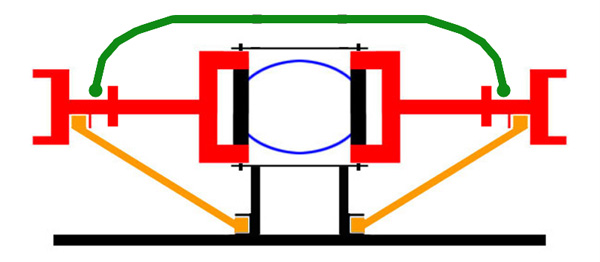
![]() Offline
Offline
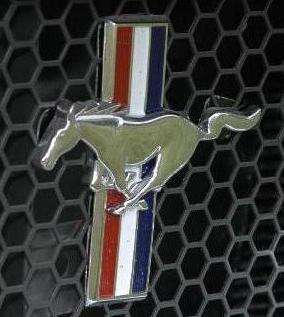
Deleted Third Option
Last edited by irstang (10/18/2010 8:45 pm)
![]() Offline
Offline
Daze / Irstang - 99 and 9/10 of the people I have talked to say DO NOT WELD half shafts from the the t-bird irs, they will not hold up because of the torsion bar that they are,I figure they have been thru it so I might as well learn from there experience,I'll figure something out, I just don't know what is right now.If it had U joints and shafts I wouldn't hesitate cutting them,I even thought about converting them to U joints,But I'm sure I wouldn't be ahead of the game cost wise.
Vern
![]() Offline
Offline

vernlee, just for my own education how are the shafts held together?? if the main shaft is not welded to the CV what holds it in place?? I would still love to see some pictures of this unit including all the individual parts and pieces. if you are having trouble posting them please email me with them and I will post them.

![]() Offline
Offline

irstang wrote:
There is a third method of making Jag half-shafts any length you want. The u-joints are common to early Chevrolets. Chevy driveshaft yokes can be used to make half shafts using steel drive shaft tubing. I had Curt Hamilton at Hamilton Automotive Industries, (818) 787-9695 make mine and they were not that expensive. Care must be taken to insure they are true and balanced. The results are half-shafts stronger than stock ones welded up.
I actually cover that option as well on my web page, however I didn't mention it because it doesn't really apply to the t-bird

![]() Offline
Offline
Daze. I just sent you some pics of the t-bird cv joints and shafts,the cv joint is held to the differental by a cir clip kinda like a C clip,but I guess you could say the thing is held in place by the control arms not allowing the half shafts to move either in or out, the outer cv joint just pulls off the axle shafts, the differental side is held in by the cir clips and come apart real hard,I hope the pics make it a little clearer, If you want to post the pics feel free, or pic and choose,
Vern
![]() Offline
Offline

vernlee wrote:
Daze. I just sent you some pics of the t-bird cv joints and shafts,the cv joint is held to the differental by a cir clip kinda like a C clip,but I guess you could say the thing is held in place by the control arms not allowing the half shafts to move either in or out, the outer cv joint just pulls off the axle shafts, the differental side is held in by the cir clips and come apart real hard,I hope the pics make it a little clearer, If you want to post the pics feel free, or pic and choose,
Vern
Now that I see how it attaches, I see why you are wanting to have them resplined. rather than having to buy other units and then having to modify them, you may be able to have something made from scratch... basically just a shaft with splines on both ends and a groove for the boot.
here are pix you sent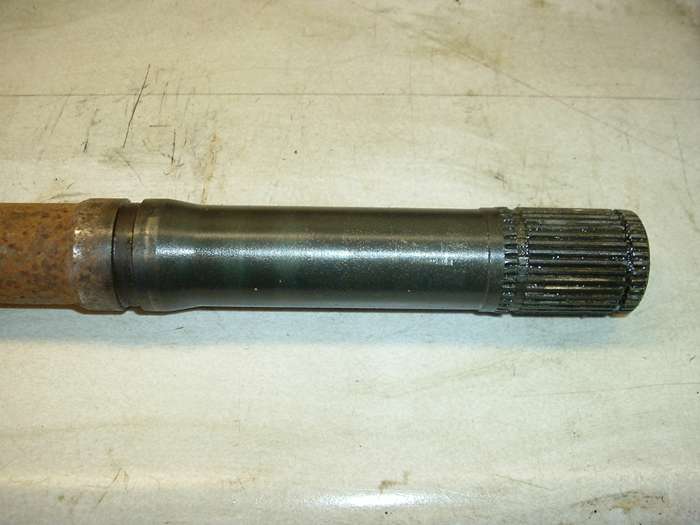
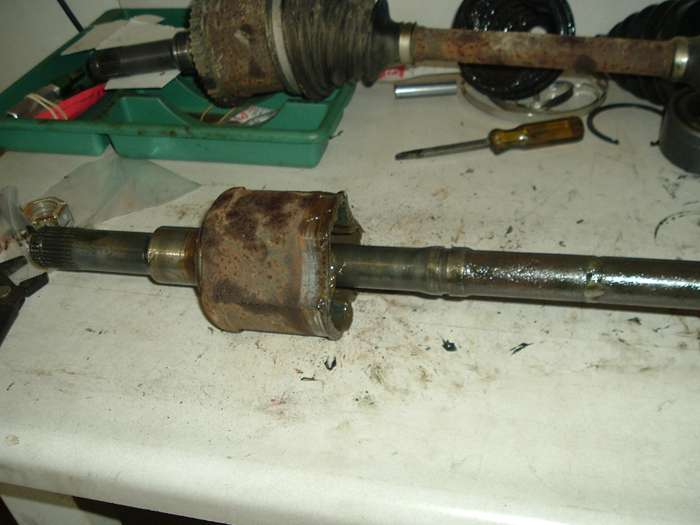
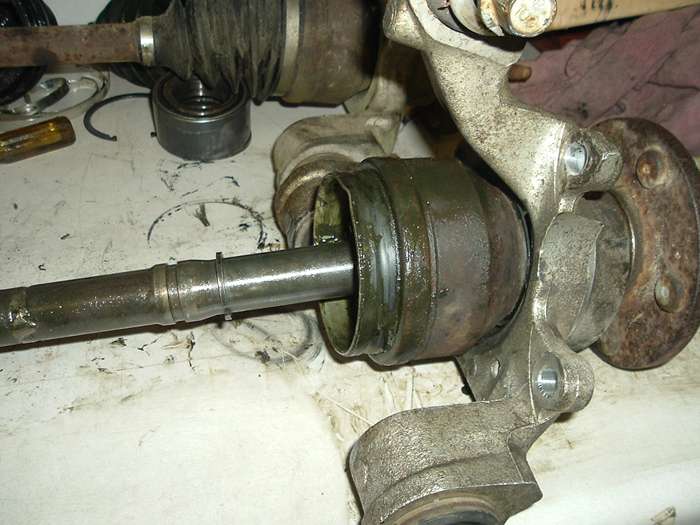
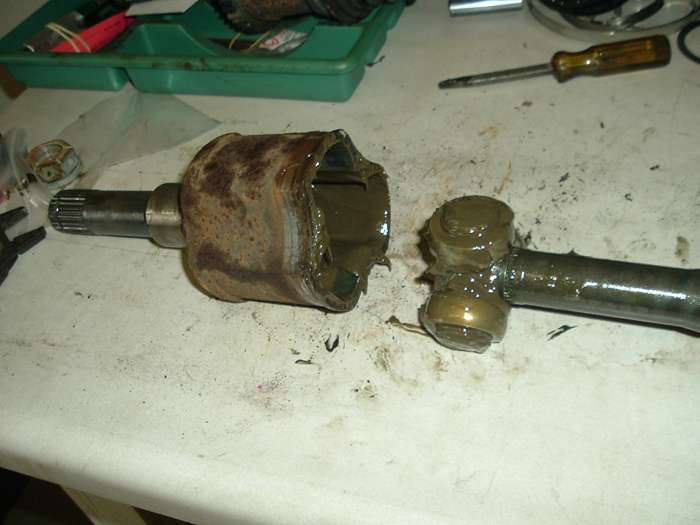
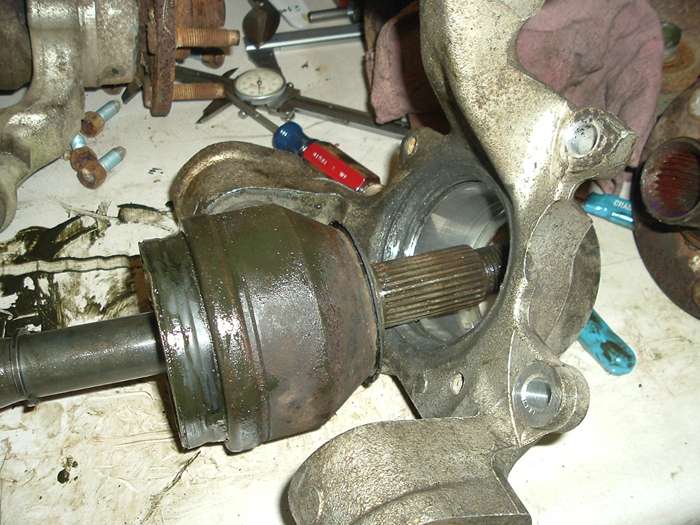
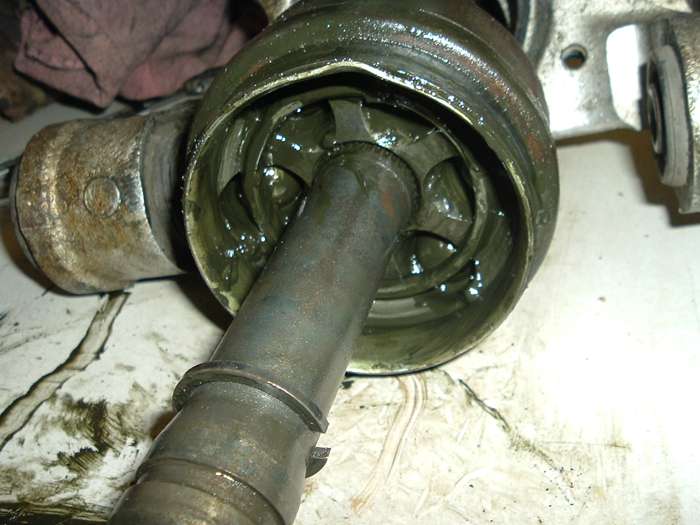


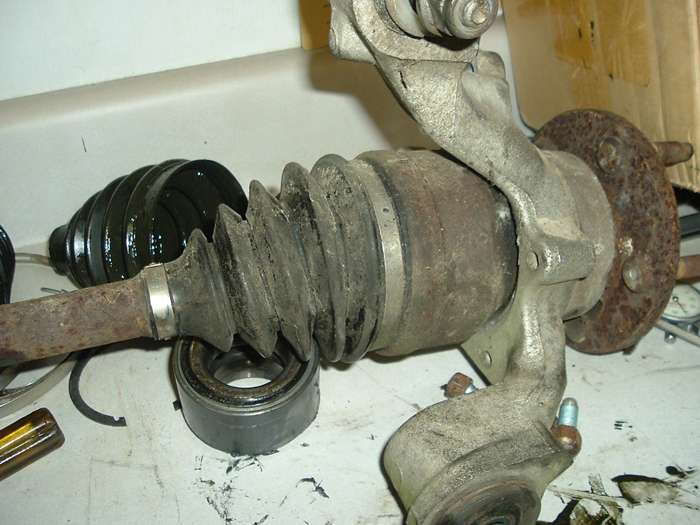
I would love to see pictures of the rest of the unit, could you email them to me???

![]() Offline
Offline

BTW how much to long are the shafts???

![]() Offline
Offline
Daze, I need 2 1/2 inches cut from each side,Sometime this week I'm going to a drive shaft shop near me to see about changing to U joints, or at least get some price ideas. the more I think about U joints the more I like the idea.
Vern
![]() Offline
Offline

Unfortunately u-joints wont work. Daze is right and we probably should delete my third option. It does not belong in this thread. The half-shafts in your pics are like of my son's front wheel drive Ford Escort. The three balls slide in and out in the cup as the suspension moves up and down. Since you have a fixed length upper and lower control arms, the half-shafts have to change length. This is unlike the Jag where the half-shaft functions as the upper control arm. Seemed to me like you could shorten the shafts and reinforce them with a tube like Daze shows in his second option. I wonder if anyone has tried it this way. Will a larger diameter tube clear the upper arm? One thing; a broken half shaft can't be as catastrophic as with a Jag. How much torque are you planning with your engine/trans/diff combo?
Last edited by irstang (10/18/2010 8:53 pm)
![]() Offline
Offline
irstang, interesting point about the half shafts haveing to move in and out , I didn't consider that, But didn't the corvette use a system like I want to do ?
Yes some guys have welded a tube around the shaft after shorting and have had some luck, but others have had catastrophic results,Clearence I don't think would be a problem,I'm running 5.4 dohc with a 5 speed,not planning on drag racing, just want to do burn outs as my heart desires ![]() just after a nice performing street ride.Didn't the corvette have upper and lower control arms with U joints on the half shafts ??
just after a nice performing street ride.Didn't the corvette have upper and lower control arms with U joints on the half shafts ??
Vern
![]() Offline
Offline

vernlee wrote:
irstang, interesting point about the half shafts haveing to move in and out , I didn't consider that, But didn't the corvette use a system like I want to do ?
It was my understanding (keep in mind I know very little about Corvette IRS) that the float was at the hub. I was under the impression that where the half shaft went in to the hub was a slip yoke just like a drive line going in to a transmission. I assumed the t-bird set up was the same, because I had not thought about the float in the CV joints.
Looks like I was incorect on both counts. As I was making this post I went to eBay and looked at the corvette IRS units listed there and the ones with u-joints don't have a UCA (at least the ones I looked at) they have a tie rod. the tie rod would act to stabilize the top of the hub and be a safety net should the half shaft fail, but given its location and set up the half shaft is still serving as the UCA, and would not need to float.
[img]!B3Br04Q!Wk~$(KGrHqMOKnIE)6NisKRCBMkrTMw!bQ~~_12.JPG[/img]
The newer corvette IRS units do have a dedicated UCA however they also use CV joints
[img]!Bu10B6!!Wk~$(KGrHqJ,!iQEv1+0BTOpBMB+6M4qbw~~_12.JPG[/img]
Like I said before I know very little about the Corvette IRS. I am taking an educated guess based on the pictures of a corvette IRS I have seen, what I know about the Jag IRS unit, and suspension in general. So if you are reading this to learn about the corvette IRS please take it for what it is, an educated guess. Also if you know more than I about corvette IRS and any of this is of this info is incorrect, please correct me... Ralphy that means you!!!

![]() Offline
Offline

Is that a weld I see on the shafts in the second and third picture?
![]() Offline
Offline
Yes, I cut and welded to length for mock up purposes,If I can't find a suitable fix for this,welding might be my only choice.
Vern
![]() Offline
Offline
O.K. here's the skinny-I went to a drive shaft shop today,And he said that what I wanted to do would work no problem at all,Yes I can change from CV joints to U joints, BUT, the cost would be around $500.00 plus alot of labor on my part to prep( grind or turn down ) the tulip for welding and fitting the yokes to,So this idea is out the window ![]() I can have two new haft shafts made for under the 500 bucks and that includes any shiping cost, and no labor for me other then reassembly which I would have with either idea,So new or welded shafts is where I'm at now.
I can have two new haft shafts made for under the 500 bucks and that includes any shiping cost, and no labor for me other then reassembly which I would have with either idea,So new or welded shafts is where I'm at now.
Vern
![]() Offline
Offline

What if you used both of the techniques I mentioned??? you could cut the shafts to length, bevel then ends, weld the shafts back together, turn the weld down flush with the rest of the axle, THEN press a sleeve over the top, and weld it on both ends. If you extended the sleeve at least 1" past the edge of the bevel you should be stronger than stock. Even if you couldn't press a sleeve over the welded section and had to cut the sleeve in half and then weld it back together on the shaft I would think you would be more than strong enough.
I live in an are where the machine shops are not set up to harden steel so when narrowing a live axle they can't cut the splines off, respline the axle then harden the splines. What they have to do is cut a section out of the middle, bevel and weld. That way they are using the original hardened steal splines. any way the local shop has done this a bunch of times and the axles are holding up. I cant see any reason why this wouldn't work and the added strength of a sleeve would make it all the better. I wish tyrellracing would weigh in on this thread. he works at a machine shop and deals with drivelines all the time. I am sure he would have some good input.

![]() Offline
Offline
Daze,I guess that is what I'll do,First I'm going to anneal the shafts,then I can cut them,put a nice deep bevel on them,slip a sleeve over the shaft weld together, slide sleeve in place weld sleeve in place, and I think I will mill some slots in the sleeve first for some heathly rossette welds,then have the shafts hardened at a local heat treating shop,I don't see why this wouldn't work, after all this will be a light weight car,and I'm not going to be racing with slicks or anything,If I wasn't so poverty stricken ![]() this wouldn't be such an issue. I'll keep you posted
this wouldn't be such an issue. I'll keep you posted
Vern
![]() Offline
Offline

You already cut the shafts once and welded them back together. The center of the shafts have already been annealed by welding. Steel is not all that great at conducting heat, so you probably have not annealed the splines by cutting and welding the center. Don't anneal the entire shaft or you'll lose the temper at the shaft splines where you need it. Keep the splines cool while you weld around the new tube and you're done. Make sure the shafts are true and balanced. If you find a pro to do this, all the better. Take the time to save enough money to do this right. Someday when you are on the freeway you'll be glad you did.
Last edited by irstang (10/19/2010 9:03 pm)
![]() Offline
Offline
What I'm going to attempt with mine is to true the ends about 4" in from the cut site (on a lathe, NOT a sawzall) from each side, chamfer the ends slightly, insert in some high carbon thick walled pipe and get the length that I need, weld back together at each section, have balanced, re-install (find out that I did something wrong and scream..)kidding)
The CV joints do NOT slide like a slip-yoke. They have a little snap ring that holds them in on the inner joint end. The movement is taken up by the actuation of the control arms keeping the flanges in "PHASE" with the diff itself, or its' housing. The problem arises with the bushings wearing/breaking that changes that/those dimensions and causes wear on the CV internals and eventually poopooing it.
I've watched a good friend rebuild them and the hardest part was to get the balls back in the cage.. Well, maybe getting the housing off could pose a true challenge of ingenuity.. (if this works I got it.. If not, do I have the $$ to get a new one)
Errol
![]() Offline
Offline
77 amc, Good luck with the lathe, That's what I tried with carbide tooling,If you take a .002 cut at a time, in a week or two you might get down where you need to be,I did manage to true the ends up after cutting the shafts into with a cutting wheel,even that was a slow process,I then drilled a half inch hole in the end and inserted a 1/2 '' peice of drill rod about a inch deep, this helped keep the shaft true for welding,now I will put a 1-5/16 X .109 wall sleeve over it and weld,I've come to the conclusion if it breaks it breaks, I'll take my chanches,I'll send pics when it done.
Vern